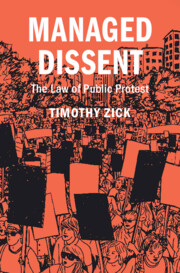Book contents
- Managed Dissent
- Cambridge Studies on Civil Rights and Civil Liberties
- Managed Dissent
- Copyright page
- Contents
- Figure
- Tables
- Preface
- Acknowledgments
- Introduction
- 1 Protest, Dissent, and Democracy
- 2 The Managerial System
- 3 Displacing Dissent
- 4 The Rising Costs of Dissent
- 5 Managing Campus Protest
- 6 Arming Public Protests
- 7 Public Protest and Emergency Powers
- 8 Protesters’ Remedies
- 9 Preserving Public Protest
- Notes
- Index
Introduction
Published online by Cambridge University Press: 04 May 2023
- Managed Dissent
- Cambridge Studies on Civil Rights and Civil Liberties
- Managed Dissent
- Copyright page
- Contents
- Figure
- Tables
- Preface
- Acknowledgments
- Introduction
- 1 Protest, Dissent, and Democracy
- 2 The Managerial System
- 3 Displacing Dissent
- 4 The Rising Costs of Dissent
- 5 Managing Campus Protest
- 6 Arming Public Protests
- 7 Public Protest and Emergency Powers
- 8 Protesters’ Remedies
- 9 Preserving Public Protest
- Notes
- Index
Summary
The Introduction discusses the importance of public protest even in a digital era. It uses the mass demonstrations that followed George Floyd’s murder to highlight both a desire to participate in public dissent and the challenges that restrict that participation. Those challenges include police aggression and violence, enforcement of vague public order laws, restrictions on the place where protests can occur, and attitudes about public contention. The idea of a body of protest law and the concept of “managed dissent” are introduced and explained.
- Type
- Chapter
- Information
- Managed DissentThe Law of Public Protest, pp. 1 - 16Publisher: Cambridge University PressPrint publication year: 2023

